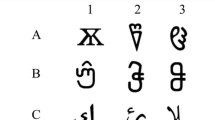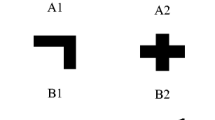Abstract
Three experiments examined whether or not the members of each stimulus class between the discriminative stimuli formed during overtraining became functionally equivalent. In Experiment 1, rats were trained on two discrimination tasks to criterion or overtrained. Then they were tested on two new discriminations, in which the negative stimuli for the original discriminations were exchanged. This manipulation had little disruptive influence. on rats’ subsequent choices following overtraining, but not after criterion training. The effect of overtraining on exchanging the negative stimuli of two discriminations was replicated in Experiment 2. Experiment 2 makes it clear that the members of each pair of stimuli begin to become functionally equivalent after the rats receive overtraining for 10 days, and become perfectly functionally equivalent after the rats receive overtraining for 20 days. In Experiment 3, half of the rats were concurrently trained on two discriminations to criterion or overtrained. The remaining rats were separately trained in one discrimination on odd days in the training phase and the other on even days to criterion or overtrained. Then all rats received testing, in which the negative stimuli between two discriminations were exchanged. There was no significant difference in test performance after overtraining between these two groups, which were very excellent. Results of Experiments 1, 2, and 3 indicate that, in rats, stimulus classes established during overtraining have two properties of stimulus equivalence relation: exchangeability and substitutability.
Similar content being viewed by others
References
DELIUS, J. D., AMELING, M., LEA, S. E. G., & STADDON, J. E. R. (1995). Reinforcement concordance induces and maintains stimulus associations in pigeons. The Psychological Record, 45, 283–297.
EDWARDS, C. A., JAGIELO, J. A., ZENTALL, T. R., & HOGAN, D. E. (1982). Acquired equivalence and distinctiveness in matching to sample by pigeons: Mediation by reinforcer-specific expectances. Journal of Experimental Psychology: Animal Behavior Processes, 8, 244–259.
GOLDIAMOND, I. (1962). Perception. In A. J. Bachrach (Ed.), Experimental foundations of clinical psychology (pp. 280–340). New York: Basic Books.
LAWRENCE, D. H. (1949). Acquired distinctiveness of cues: I. Transfer between discriminations on the basis of familiarity with the stimulus. Journal of Experimental Psychology, 39, 770–784.
LAWRENCE, D. H. (1950). Acquired distinctiveness of cues: II. Selective association in a constant stimulus situation. Journal of Experimental Psychology, 40, 175–188.
MACKINTOSH, N. J. (1962). The effect of overtraining on a reversal and a nonreversal shift. Journal of Comparative and Physiological Psychology, 55, 555–559.
MACKINTOSH, N. J. (1964). Overtraining and transfer within and between dimension in the rat. Quarterly Journal of Experimental Psychology, 16, 250–256.
MACKINTOSH, N. J. (1965a). Selective attention in animal discrimination learning. Psychological Bulletin, 64, 124–150.
MACKINTOSH, N. J. (1965b). Overtraining, reversal, and extinction in rats and chicks. Journal of Comparative and Physiological Psychology, 59, 31–36.
NAKAGAWA, E. (1978). The effect of overtraining on discrimination learning in white rats (in Japanese). Japanese Journal of Psychology, 49, 70–77.
NAKAGAWA, E. (1986). Overtraining, extinction and shift iearning in a concurrent discrimination in rats. Quarterly Journal of Experimental Psychology, 38B, 213–226.
NAKAGAWA, E. (1992). Effects of overtraining on reversal learning by rats in concurrent and single discriminations. Quarterly Journal of Experimental Psychology, 44B, 37–56.
NAKAGAWA, E. (1998). Stimulus classes formation process in concurrent discriminations in rats as a function of overtraining. The Psychological Record, 48, 537–560.
SHIPLEY, W. C. (1935). Indirect conditioning. Journal of Genera! Psychology, 12, 337–357.
SIDMAN, M. (1986). Functional analysis of emergent verbal classes. In T. Thompson & M. D. Zeiler (Eds.), Analysis and integration of behavioral units (pp. 213–245). Hillsdale, NJ: Erlbaum.
SIDMAN, M., & TAILBY, W. (1982). Conditional discrimination vs. matching to sample: An expansion of the testing paradigm. Journal of the Experimental Analysis of Behavior, 37, 25–44.
SPENCE, K. W. (1936). The nature of discrimination learning in animals. Psychological Review, 43, 427–449.
SPENCE, K. W. (1937). The differential responses in animals to stimuli varying within a single dimension. Psychological Review, 44, 430–444.
SPRADLIN, J. E., COTTER, V. W., & BAXLEY, N. (1973). Establishing a conditional discrimination without direct training: A study of transfer with retarded adolescents. American Journal of Mental Deficiency, 7, 556–566.
SPRADLIN, J. E., & SAUNDERS, R. R. (1986). The development of stimulus classes using match-to-sample procedures: Analysis and Intervention in Developmental Disabilities, 6, 41–58.
URCUIOLI, P. J., ZENTALL, T. R., JACKSON-SMITH, P., & STEIRN, J. N. (1989). Evidence for common coding in many-to-one matching: Retention, intertrial interference, and transfer. Journal of Experimental Psychology: Animal Behavior Process, 15, 264–273.
VAUGHAN, W., Jr. (1988). Formation of equivalence sets in pigeons. Journal of Experimental Psychology: Animal Behavior Processes, 14, 36–42.
ZENTALL, T. R., STEIRN, J. N., SHERBURNE, L. M., & URCUIOLI, P. J. (1991). Common coding in pigeons assessed through partial versus total reversals of many-to-one conditional and simple discriminations. Journal of Experimental Psychology: Animal Behavior Processes, 17, 194–201.
Author information
Authors and Affiliations
Rights and permissions
About this article
Cite this article
Nakagawa, E. Acquired Equivalence of Discriminative Stimuli Following Two Concurrent Discrimination Learning Tasks as a Function of Overtraining in Rats. Psychol Rec 49, 327–348 (1999). https://doi.org/10.1007/BF03395323
Published:
Issue Date:
DOI: https://doi.org/10.1007/BF03395323




